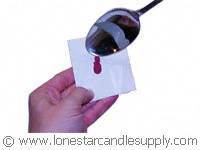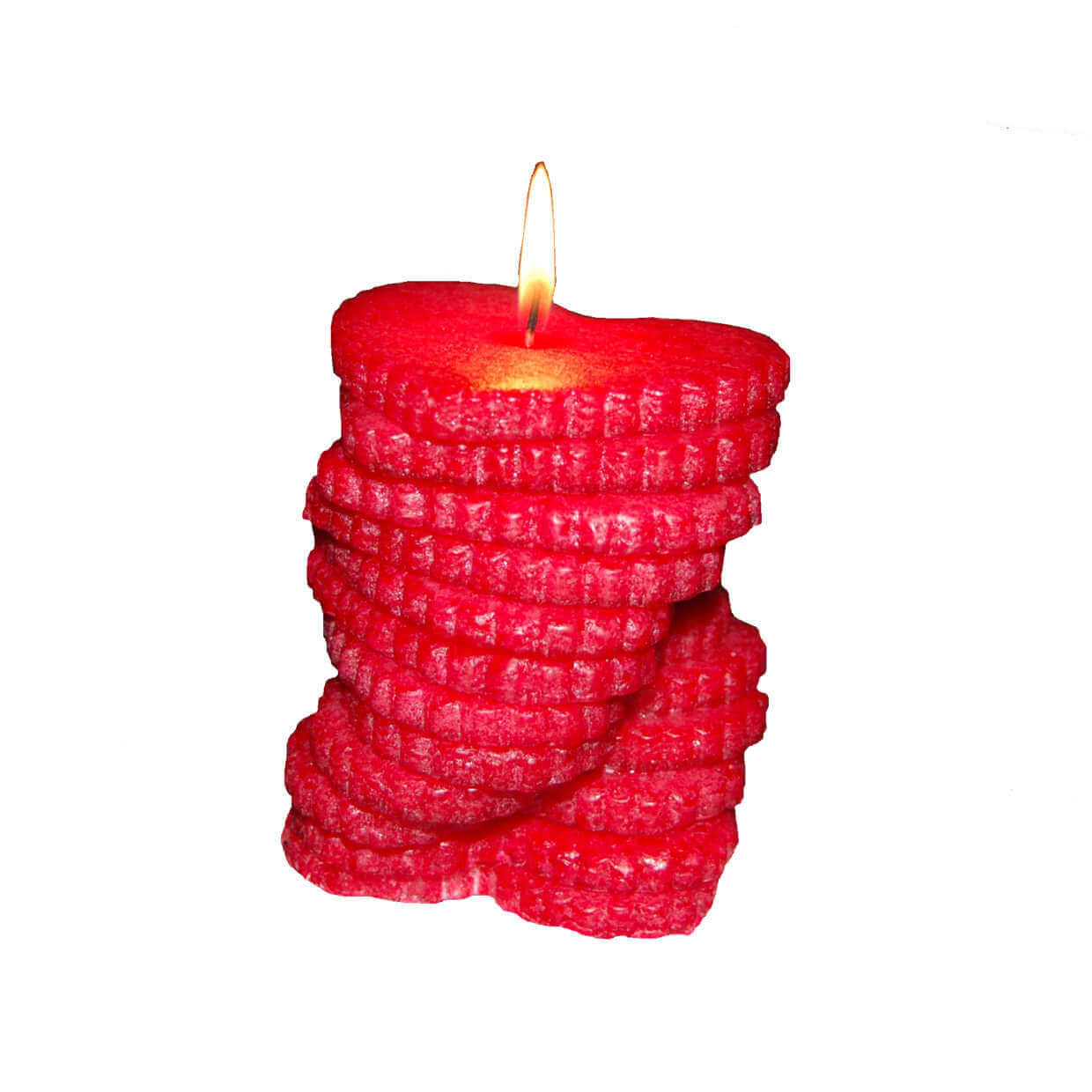How to Make Cookie Cutter Pillars
Start by gathering all the items that you will need. The process will go much more smoothly if everything is readily accessible. Our Candle Making Starter Kit for Pillars contains many of the items found in this tutorial.

Here's What You'll Need:
Butcher Paper or Newspaper
Paper Towels
UV Stabilizer (optional, but recommended)
Cookie Sheet or Pan
Butter Knife
Metal Spoon or Stir Stick
Sauce PAn
Skewer
Utility Knife
Wick Trimmers, Scissors, or Nail Clippers
Metal Cookie Cutter or Trivet
This project is easy, fun, and can be adapted easily to different holidays by simply using different cookie cutters. Cover your work area with butcher paper or newspaper. Spills or drips are most times unavoidable, and clean-up is much easier if you don’t have to clean wax off of your work surface.

Step 1
For this project a 15.25" x 10.25" x .75" cookie sheet and IGI 4625 wax was used.

Step 2
Cutting the pillar waxes can be tricky. For this demonstration, the wax is scored with a utility knife. Then, the scored piece is placed on the remaining slab and pressure is applied to help break the wax on the score. You may need to do this a few times to get the wax in small enough pieces to fit in the pouring pot. (Be careful not to cut yourself or smash your fingers while doing this.) The wax can be weighed in the pouring pot so you do not have to transfer it from a different container.

Step 3
The wax will need to be heated in a double boiler to 175° - 185°F, depending on the wax you have chosen. To create a double boiler, put about an inch of water in the saucepan, and then place the pouring pot in the water. It is a good idea to add an inexpensive metal trivet or metal cookie cutter under the pouring pot to elevate it. Doing this ensures the wax is not receiving direct heat from any side. Adjust the heat to a medium-low setting. The water needs to be boiling, but it does not have to come to a rolling boil. If the water is at a rolling boil, it may splatter out of the pan. Check the temperature of the wax occasionally to make certain it is not getting too hot. Adjust the temperature as needed. While the wax is melting, use a cooking spray and coat the cookie sheet that will be used. This will help the wax to release more easily when the wax has cooled.

Step 4
Once the wax has reached the proper temperature, you are ready to add the fragrance oil. Depending on the wax you are using, you could add 0.5 – 1.0 ounce of fragrance per pound of wax. It is most common to add 1 ounce of fragrance per pound of wax. The fragrance is most accurately measured by weight, but you can also use a tablespoon to measure it if the scale you have does not measure a small amount precisely. A tablespoon is equal to about 0.5 ounce. Pour the fragrance into the wax and stir it.

Step 5 (using dye blocks)
Next, add the desired amount of dye. If using dye blocks, the block will melt into the wax more quickly if it is cut into small pieces. After adding the desired amount, stir the mixture until it is blended thoroughly. Skip to step 7 if you are using dye blocks.

Step 5 (using liquid dye)
If using liquid dyes, just add the desired amount of drops. Since you can not remove dye once it has been added, it should be added sparingly, especially if you are trying to achieve a light color. You can always add a little more if it is not dark enough. After adding the desired amount, stir the mixture until it is blended thoroughly.

Step 6
When you look at the liquid wax, it will usually look much darker than when it has completely cooled. To test the color, you can drip a small amount of wax onto a paper plate or paper towel. (Make sure not to drip the hot wax on your hands). Allow it to harden, and you will be able to see a more accurate representation of the color. You can then add more dye if desired.

Step 7
At this point, you can add UV stabilizer if you choose. The addition of UV stabilizer will help keep the color from fading if the candles are exposed to UV rays or fluorescent lighting. You would add about ½ teaspoon per pound of wax. Mix everything together very thoroughly. Mixing it for 3 – 5 minutes would be best. Check the temperature again to make sure it is between 175° - 185°F. Remove the pouring pot from the double boiler. The handle of the pouring pot may heat up slightly, so be sure to use a hot pad or something to protect your hand. You may also want to set the pouring pot on a few paper towels to absorb the water from the double boiler.

Step 8
Slowly fill the cookie sheet. Do not pour too quickly or wax will splash off the cookie sheet. Fill the cookie sheet or pan about 1/4" deep. It may be necessary to elevate part of the pan if it is not on a level surface.

Step 9
Let the wax harden, but it should still be warm. You can test a small corner of the wax to see if it is ready. Press the cookie cutter into the wax. The wax should be pliable, but you do not want it to be liquid in the center. If wax seeps from the edges when you remove the cookie cutter, let it cool a little longer. The shape can be cut again if this happens.

Step 10
Use the cookie cutter to make preliminary cuts in the wax; make sure to press it firmly to the pan. Do not try to remove the wax pieces as you cut them because they will still be too soft. The wax needs to cool more before you remove them, but you don't want it to cool completely. Allow the wax to cool for a short time, and then use your cookie cutter to cut the shapes again.

Step 11
It is easiest to cut the excess wax from around the shapes rather than trying to remove the shapes first. Using a butter knife, cut small pieces of the excess wax making sure not to disturb the shapes you have cut. Lift the shapes from the cookie sheet using a spatula. They can be left on the cookie sheet or placed on butcher paper.

Step 12
Choose one of the shapes to use as a guide for creating a wick hole. Using the sharp end of a skewer, carefully poke a hole in the center of the shape. Then place your guide piece on top of the others individually to use it as a template so your wick holes will be consistent.

Step 13
Gently thread the wick through the holes in the shapes. Be careful with the first 2 - 3 pieces as you press them over the wick tab; these pieces may fracture or break if the wax has cooled too much. Apply a pillar caution label to the bottom.

That's it!
You're finished! - You can stack the shapes evenly or spiral them to create a different look. You can also vary the colors that you use or use varying sizes to give your candle a tapered appearance. Be creative!
Are you ready to give it a try? Get everything you need to start making candles by browsing our selection of candle making supplies or by simply clicking on the items in the Materials List at the top of this page to take you directly to that item on our website. Have fun!
NOTE: Be careful when moving these candles. They are individual pieces that are not secured together in any way. Make sure you pick them up with support on the top and bottom.
Tag us if you share your creations on your social media accounts! You can use the hashtag #lonestarcommunity and see your beautiful creations on our Lone Star Community Page.